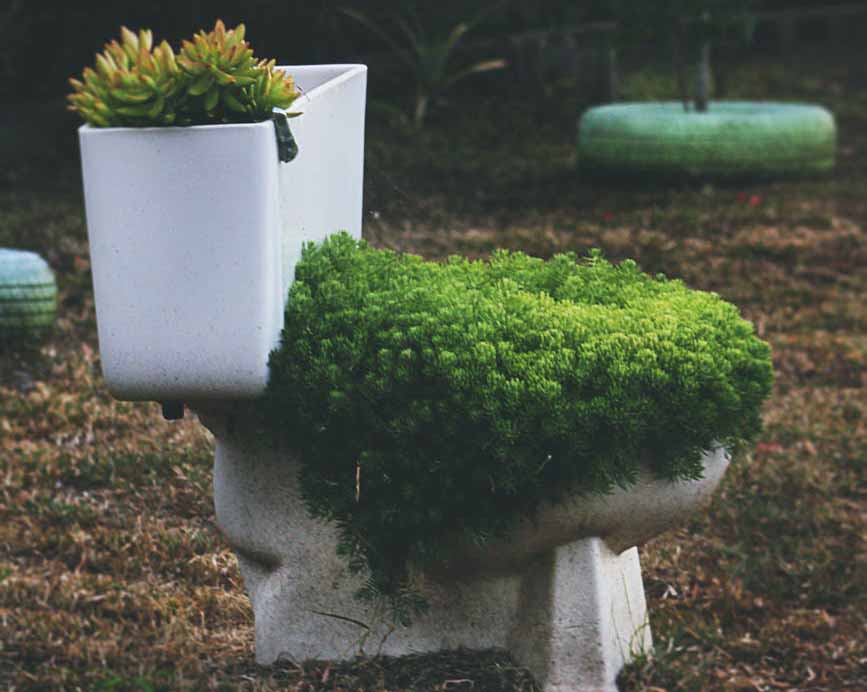 |
|
| Issue #79 • January/February, 2003 |
When our solar business started to really increase, I found myself spending more and more time in my truck traveling down the highway to very remote job sites. My first investment was to buy a good quality parts trailer when I outgrew the back of my truck. Unfortunately, I soon learned that when mother nature calls, I was either working on houses still under construction that did not have a working plumbing system, or on the road many miles from the next drive-thru.
Although I do not own an RV, I have watched RV owners go through their daily routine of connecting temporary drain pipes, emptying holding tanks, flushing gray water tanks, and refilling a fresh water tank just to have a working toilet. Since I am basically lazy, I knew the solution to my problem would definitely not involve installing a typical RV flush toilet in my work trailer.

All mounting and venting hardware was included with the Sun-Mar kit.

Three 75-watt solar module installed on the side of a 12-foot storage trailer

Initial mounting of self-contained compost toilet in trailer. A plywood wass was installed to create the restroom.

12-volt DC exhaust fan and 3-inch vent piping after installation

Placing the bags of Zeolite and activated charcoal in the fan box

Initial filling of the rotating drum with compost

Dual 6-volt gel cell golf cart batteries and backup AC battery charger

Closeup view of solar charge controller and fan shut-off switch
After extensive research (net surfing) with my trusty laptop, I found several suppliers of toilets that did not require water connections, sewer connections, septic tanks, or holding tanks. This seemed too good to be true, but there was a catch: to eliminate any odors and increase liquid waste evaporation, most of these units include a small exhaust fan that must operate continuously. In addition, during cold weather or higher use rates, most models include a small thermostatically controlled heater plate to prevent freezing of the damp mulch and to increase liquid evaporation.
So the question is, can this type of toilet operate satisfactorily without having the convenience of a grid connected 110-volt AC wall outlet? I decided that I would not need the auxiliary electric heater plate due to my limited weekly usage. If this ever became a problem, I could temporarily power the heater plate from an extension cord to the garage when parked at home. This leaves the small exhaust fan that must be powered full time. Further research found that almost all manufacturers of self-contained remote cabin toilets have modified versions for mobile applications like boats and RVs which replace the standard 120-volt AC fan with a 12-volt DC fan.
Brief history
The first non-traditional water flush toilets were developed in Europe in the 1960s for small rural mountain cottages. These operated on the principle of incinerating the waste. Although this technology is still in use today, the high electric consumption needed for operation makes this design not very practical for solar power or mobile applications.
Today there are several manufacturers for composting toilets which are available in many different sizes, styles, and capacities. Some high capacity units are as large as refrigerators laying on their side, and they are usually installed under the bathroom floor or in a basement. Smaller versions are self-contained and include special mounting hardware for installation in RVs and boats. Some models still utilize limited water flushing toilet seats in their operation, while others do not. Several have a manual hand crank to turn the compost drum and some use an electric motor.
Installation
I decided to purchase the Sun-Mar Ecolet Mobile toilet and was very surprised when it was delivered. I was expecting to receive just a toilet, and like most products requiring installation, I was dreading the multiple treks to the building supply store to purchase the missing odd sized pipe fittings, special mounting hardware, and hard to find supplies. Instead, the shipping box included the toilet, all required three-inch vent piping, a one-inch pipe drain pipe, flex exhaust pipe, all mounting bolts and brackets, a large bag of mulch, and initial start-up supplies.
First I built a plywood divider wall inside the work trailer to create a small bathroom area with access from the side door. Unpacking the 50-pound toilet and mounting it in the work trailer took less than 30 minutes. It took another two hours to install the vent pipe because I had to cut a 3-inch vent hole in the metal trailer wall, which I finished with a plastic exhaust grille I found at a marine supply store. The toilet vent pipe extends up to the exhaust fan using the 3-inch PVC pipe, then it is routed at an angle to the upper side trailer wall using the various vent pipe fittings and flex duct provided. The instructions recommended a more vertical pipe route with minimum turns, but I wanted to avoid making a roof penetration. Now that the toilet installation was complete, how could I power this thing?
Solar power system
The 12-volt DC exhaust fan for the mobile version of the Sun-Mar toilet consumes 4 watts of power and must operate continuously, which equals 96 watt-hours per day (4 x 24 hrs.). Assuming there will be several days per week of cloudy weather, I decided to use a larger 75-watt solar photovoltaic panel to provide the fan power, which leaves more than enough solar energy for battery charging. Since most locations in this country receive at least 4 to 5 hours of peak sun per day, this should provide 300 watt-hours per day (75 watts x 4 hrs.) which is three times the exhaust fan daily load.
A battery allows storing the excess solar energy collected during the day so the fan and light can continue to operate at night and during periods of inclement weather. I chose two 6-volt gel cell golf cart size batteries which are designed to handle the daily deep charge/discharge solar cycle that would soon destroy a standard car battery. The gel cell version of this battery eliminates the need for periodic water refilling and does not require a liquid electrolyte that could spill, which is perfect for mobile applications.
The two 6-volt batteries wired in series provide the 12-volts needed for the fan and lights. A solar module should face south in the northen hemisphere to maximize solar collection, which is a problem for a mobile application that could be facing any direction while parked or moving. Mounting the module flat on the roof would produce the same solar energy collection regardless of which way the vehicle is turned, but the flat mounting angle would greatly reduce winter performance due to the low sun angle. I decided to mount the 75-watt module on the side of the trailer that faces south when parked next to my house. This provides a fully charged battery for the next trip or project.
You cannot wire batteries directly to a solar module without a solar charge controller, as this would overcharge the battery during a sunny day and discharge the battery at night. I purchased a Morningstar Model 55 photovoltaic 12-volt charge controller with low voltage disconnect option. This is an excellent controller designed to charge both liquid and gel cell batteries, and its low voltage load disconnect will keep the exhaust fan from totally discharging the battery during long periods of cloudy weather. It has many built-in safety features and a small LED light to indicate charging status. I added a switch and in-line automotive type fuse between the controller and the exhaust fan. This allows shutting off the fan for extended non-use periods, which greatly increases battery life.
Since the trailer now had a fully functioning solar charged battery system of its own, it seemed a waste to only power a tiny toilet exhaust fan, so I disconnected the interior dome lights from the trailer hitch electrical feed and rewired these to the new solar power system. This is really convenient when you need to find a tool or part inside and the trailer is not connected to the tow vehicle for power. I also added a small 12-volt fluorescent light that includes its own switch and produces much more light than the small dome light, and a 120-volt AC battery charger to plug in when parked for extended periods as a backup for the solar charging system.
To complete my bathroom on wheels, I installed a standard vanity sink base and a very deep sink basin. The deep sink will hold a large volume of water without splashing out when moving if I am parked where draining the soapy water onto the ground is not acceptable. I purchased a 15-gallon RV fresh water tank and exterior mounted hose fill plug from a marine supply store, which I mounted near the ceiling directly above the sink. At this elevation, a pressure pump or expansion tank is not required. Opening the sink faucet allows the water in the tank to drain into the sink. Although the water is not heated, it does allow washing your hands and face at job or camp sites that do not have restroom facilities.
So where’s the smell?
After the installation was complete and in use, I was expecting what I usually smell (and unfortunately see) in those portable fiberglass johns everyone rents for fairs, races, and large public events. However, a composting toilet is very different. First, the seat is higher above the floor, so a small fold down step increases comfort. This increased height is necessary to accommodate the large rotating drum and various internal chambers, but this design also increases the visual distance down which almost completely blocks your view of what you may prefer not to see.
The exhaust fan is mounted inside a fiberglass box having a removable lid. During installation and setup, two nylon mesh bags (also included with the supplies) are placed in this fan box. The first bag contains what looks like limestone rocks, but are actually Zeolite. This natural mineral is a virtual “sponge” for ammonia, a common by-product of urine. The second bag contains activated charcoal pellets, a material that can remove most other objectionable contaminates except ammonia from the exhaust air. Together these materials filter and remove all “smell” from the toilet exhaust air, so the odor is completely gone even if you were standing right next to the exhaust outlet. Since this fan runs continuously, room air is drawn down through the lid and into the toilet, meaning there is no possibility of foul air floating up and out of the interior chambers prior to being filtered and exhausted.
How it works
|
During initial setup, several cubic feet of peat mulch is added to the rotating drum through a small flip door that lines up with the opening under the toilet seat. A small packet of harmless bacteria and a half-gallon of warm water is also added to get the bacteria-driven compost process started. After every few uses, you dump in a scoop of mulch from a closed storage container normally located next to the toilet. After adding the mulch, a front-mounted crank is turned several times which rotates the compost drum inside the toilet. A mechanical latch prevents the drum from stopping out of line with the top opening. This drum rotation covers the waste and mixes everything together much like you do with a compost pile. When the drum is rotating, the small flapper door closes to keep the composted material from falling out the bottom. Just below this rotating drum is a removable drawer that holds any already composted waste, which at this point is virtually organic dirt. The drum also includes a screen that allows any excess liquid to drain into an evaporator tray located at the bottom of the toilet below the removable drawer. Although completely sealed thanks to the one piece molded construction, this tray includes a one-inch plastic safety overflow pipe which prevents any spillage if the toilet is used by far more people than it was designed to handle. The small 120-volt AC heating element and automatic thermostat are located directly under this evaporator tray. This heater greatly speeds up waste liquid evaporation when the toilet is used on a daily basis.
Assuming the toilet is not used by more people and more often than it was designed for, the finishing or holding drawer may only need to be emptied once or twice each year. When the rotating drum is almost full, you turn the crank “backwards” for several turns which causes the flapper door to open and some of the composted material to fall down into the drawer where it will finish its composting and drying. Although at this point I have not needed to empty this drawer, the manufacturer assures me this material is harmless and can be used as garden fertilizer. As for me, I’m thinking garbage bag into the trash can when that time finally comes.
Conclusions
Whether you are building a remote weekend cabin and do not or cannot install a conventional flush toilet and septic system, or looking for a toilet for your RV or boat that does not require daily draining, there is a compost toilet available in a size and configuration to meet almost any application.

Wiring diagram
[weaver_widget_area id=’articles_about_yago’ class=’text3′]














